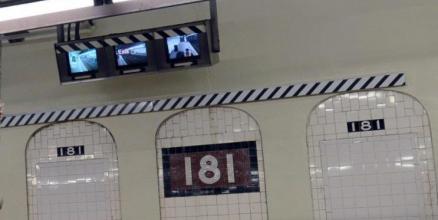Safety Zebras
In the fall of 2013, a group of New York City-area friends noticed a particular curiosity when riding the subways. If you stand toward the middle of the train platforms, you’ll see the conductors point toward the wall when the train comes to a stop in the station. The conductors are pointing at a black-and-white striped sign which hangs from the ceiling or is attached to the wall at all of the subway system’s 450 or so stations (see above), and this aforementioned group of friends used this as an opportunity to brighten the conductors’ days a bit. They made the (arguably PG-13) video below where they stand in the middle of the platform, holding signs containing messages to the train crew, often referencing the conductors’ habit of pointing.
Why?
Because it probably saves lives. Maybe even lots of them. (And it probably isn’t all that silly.)
The boards are called “conductor indication boards.” Metro Transit Authority (MTA) — the agency which operates the NYC subways — notes that they’ve been around for nearly a century. They were first installed when advancements in train technology allowed one conductor to open the car doors for more than two cars. But that creates a problem — what if the train isn’t aligned with the station’s platform? The MTA explains:
If the train operator pulls up short, the rear of the train could still be out in the tunnel and if the train slides out of the station at the front end even by a few feet – well, you get the idea.
In either case, the conductor should not open the doors. But how does the conductor know if the train has stopped at the proper location? It’s all in black and white. The conductor’s indication board is a black and white striped board of wood situated in the middle of the platform and facing the train. When the train is aligned properly, the board is directly in front of the conductor’s window and he knows that it is safe to open the doors.
That explains why the boards are there, but it doesn’t quite explain the pointing requirement. The history there is a little more muddled.
The MTA says that the rule came into force in September of 1996 and has its origins in Japanese subway safety history — Japan’s operators have to point at a number of things to demonstrate and ensure that they’re paying attention. The MTA adopted the rule to ensure the same result. A failure to acknowledge the zebra sign is a failure to pay attention, and that’s really dangerous if you’re driving a train.
And while rare, major subway accidents do happen. On reddit, a person purporting to be a NYC “tour guide and historian” asserts that the point-at-the-sign rule was part of larger safety changes made after a 1991 subway accident which resulted in five deaths and more than 150 injuries — all because the motorman (not the conductor, as I said originally, oops!) was intoxicated and going too quickly. The accident shut down the affected subway line for days and the motorman was sentenced to 15 years in prison (he was released early, in 2002). The MTA instituted sweeping safety changes following the incident, perhaps including the point-at-the-zebra rule.
Bonus Fact: Take a close look at a zebra (here are pictures) and you’ll note something cool about their stripes — they change direction, and in a consistent, predictable way. The stripes run vertically across the animal’s head and body, but horizontally down its legs.
From the Archives: Razzle Dazzle: More about things that look like zebras.
Related: A sixteen-foot long zebra decal.

